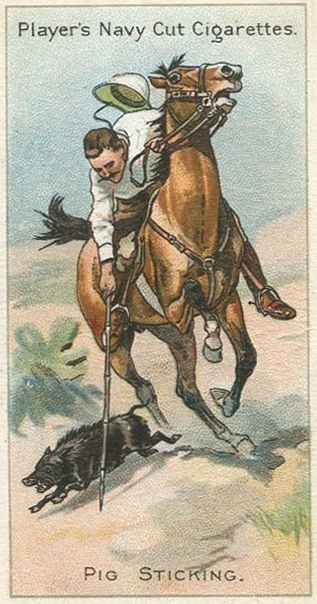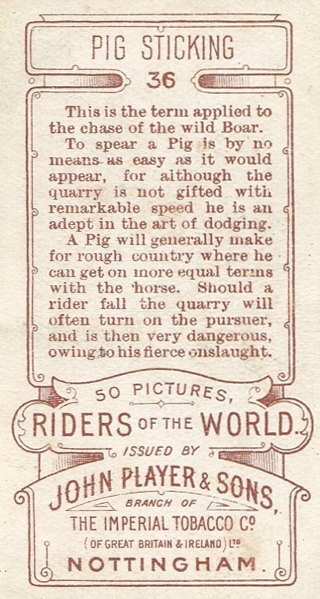වල් ඌරන් දඩයම Kadir Cup: champion pig stickers in India
B-P's Pig-Sticking or Hog-Hunting (1915/1924) is the classic work on this dangerous sport. He provides a shorter treatment of the subject in his autobiography Lessons from the Varsity of Life. "The Boar," he writes, "who deserves a big B whenever he is mentioned, is the King of the Jungle. He is the one beast that no other, except possibly the blundering old rhino, will face. When he comes down to drink at the water-hole all other people, including tiger and buffalo and elephant (especially elephant), sneak away, and believe that after all they are not very thirsty or think they will try for a drink somewhere else.
Baden-Powell and his friend Kenneth MacLaren pigsticking with HRH the Duke of Connaught. From a drawing by Baden-Powell
THE BOAR
I once adjured Mr. Rudyard Kipling to add to his jungle
yarns some notice of the two greatest characters of the wild, who felt that so far their
existence was rather ignored in his jungle books these were the Boar and the Mallard, both
of them creatures of character. The Boar, who deserves a big B whenever he is mentioned,
is the King of the Jungle. He is the one beast that no other, except possibly the
blundering old rhino, will face. When he comes down to drink at the water-hole all other
people, including tiger and buffalo and elephant (especially elephant), sneak away, and
believe that after all they are not very thirsty or think they will try for a drink
somewhere else. It isn't that he smells or slobbers, but he is so nasty
with his tusks. He is the only animal that will go for you without being first roused,
because he is the only beast that is habitually crusty. An old African buffalo, or a Canadian bison, has, of
course, his spells of crustiness, and is then unpleasant, but the boar is always peeved
about something or other.
 |
A Canadian bison has his moments
of crustiness
|
Well, that is the fellow we hunt in India on horseback with spears, and there is no sport can touch hog-hunting for excitement or valuable training.
Pig-Sticking
Colonial Film
talked about the romantic excitement in which the British Raj held
pig-sticking, noting that this kingly sport in India began only in the
early 1800s, and grew out of the decline in bear-sticking and bear
hunting with dogs. Under pressure of hunting the bears retired to the
heavy forest, with wild boar quickly replacing them as the game of
choice, being both plentiful and good sport. Strong, fast and aggressive
when threatened, the characteristics of wild boar rendered it ideal
game, both from a sporting and moral point of view – the boar was a
combination of speed, cunning and ferocity who fought to the end with
the utmost courage…a very brave opponent.
In introducing the imperial sport of pig-sticking, The British Empire and Commonwealth Museum has amazing footage of the annual Raj sporting event, the Kadir Cup Meeting.
The museum suggested that the earliest of the pig-sticking tent clubs
seems to be the Poona club, founded early in the C19th. And as
the century progressed, the event was held annually in Meerut near
Delhi, taking place over three days and drawing increasingly large and
excited crowds. Country Life magazine called pig-sticking a national obsession in the British Raj, the Wimbledon of its sport.
Each hunter on horseback carried a 6' spear which was grasped near the butt-end and used overhand, driven down at close quarters into the hog. Umpires supervised the hunt and the first rider to hold up a bloodied spear progressed to the next round in the competition.
The most famous winner (in 1883) of the Kadir Cup was Sir Robert Baden-Powell who wrote a book on the sport called Pig-Sticking or Hog-Hunting: A Complete Account for Sportsmen - And Others, published in 1924. Lord Baden-Powell was a lieutenant-general in the British Army in India and Africa, and was the founder of the Scout Movement in 1906. People took notice of his opinions.
One of his chapters was titled Pig-Sticking’s Value to the Indian Civil Service. Here the author suggested that the sport offered a model of the panacea that the Raj might need, for on the pig-sticking field it could be shown that the white man and the Indian can be mutually good friends and comrades where they have a sport in common. The Indians could learn about teamwork, authority, planning and responsibility. The Indians, in return, could share their knowledge of local geography and of local wildlife.
The British Empire and Commonwealth Museum noted that the sport was associated with the higher echelons of the military and colonial administration, and was seen as an ideal pastime to aid in the improvement of the colonial classes. In colonial India, in particular, young officers out of Britain had to get accustomed to the heat. Pig sticking discouraged young men from the "morally deleterious escape to higher altitudes" in the hot season, so that the long, hot nightmare season became instead the healthiest and happiest part of the year. And this sport took the young civilian out into his district, allowing him to enter into ‘friendship with his headmen, which cannot be got through official correspondence and chuprassies’.
The 1934 footage from Colonial Film acknowledged that while the more
serious literature showed how quickly a fun pastime could be invested
with the utmost symbolic gravity, the purely hunterly writing about the
sport was more straightforward about the other connected pleasures. The
film provided a less varnished picture of the sport in its Imperial
context, providing evidence of the luxuries the pig-sticking set
expected to enjoy when at a hunt meet or just out for sport with a
riding mate.
Wonderful photos of the post-hunt moment are available in Africa Hunting. The men are beautifully groomed, fully dressed and lined up in proud rows. The vanquished animals lie in a row in the front of each photo, trophies from a very successful day out. So which was the most important moment of the entire day - the preparations, the event's starting horn, the frantic chase or the first kill? I would suggest the post-hunt photos, complete with trophies.
The hunters on horse back with their spears
Each hunter on horseback carried a 6' spear which was grasped near the butt-end and used overhand, driven down at close quarters into the hog. Umpires supervised the hunt and the first rider to hold up a bloodied spear progressed to the next round in the competition.
The most famous winner (in 1883) of the Kadir Cup was Sir Robert Baden-Powell who wrote a book on the sport called Pig-Sticking or Hog-Hunting: A Complete Account for Sportsmen - And Others, published in 1924. Lord Baden-Powell was a lieutenant-general in the British Army in India and Africa, and was the founder of the Scout Movement in 1906. People took notice of his opinions.
One of his chapters was titled Pig-Sticking’s Value to the Indian Civil Service. Here the author suggested that the sport offered a model of the panacea that the Raj might need, for on the pig-sticking field it could be shown that the white man and the Indian can be mutually good friends and comrades where they have a sport in common. The Indians could learn about teamwork, authority, planning and responsibility. The Indians, in return, could share their knowledge of local geography and of local wildlife.
The British Empire and Commonwealth Museum noted that the sport was associated with the higher echelons of the military and colonial administration, and was seen as an ideal pastime to aid in the improvement of the colonial classes. In colonial India, in particular, young officers out of Britain had to get accustomed to the heat. Pig sticking discouraged young men from the "morally deleterious escape to higher altitudes" in the hot season, so that the long, hot nightmare season became instead the healthiest and happiest part of the year. And this sport took the young civilian out into his district, allowing him to enter into ‘friendship with his headmen, which cannot be got through official correspondence and chuprassies’.
The grand prize, Kadir Cup, with a wild boar on the cover
Wonderful photos of the post-hunt moment are available in Africa Hunting. The men are beautifully groomed, fully dressed and lined up in proud rows. The vanquished animals lie in a row in the front of each photo, trophies from a very successful day out. So which was the most important moment of the entire day - the preparations, the event's starting horn, the frantic chase or the first kill? I would suggest the post-hunt photos, complete with trophies.
Pig Sticking in India during the British Rule...
Pig Sticking in IndiaHunting Pigs with spears
Pig sticking , or hog hunting, the chase of the wild boar, as a sport, on horseback with the spear. The chase on foot was common among ancient peoples, and in central Europe has lasted to the present day, although, on account of the introduction of fire-arms, the spear has gradually become an auxiliary weapon, used to give the coup de grace to a wounded animal. The modern sport is the direct descendant of bear spearing which was popular in Bengal until the beginning of the 19th century, when the bears had become so scarce that wild pigs were substituted as the quarry. The weapon used by the Bengalese was a short, heavy, broad-bladed javelin. British officers introduced the spear or lance and this has become the recognized method of hunting wild pigs in India. The season for hunting in northern India, the present headquarters of the sport, is from February to July. The best horses should be quick and not too big. Two kinds of weapon are used. The long, or underhand, spear, weighing from two to three pounds, has a light, tough bamboo shaft, from seven to eight feet long, armed with a small steel head of varying shape. This spear is held in the hand about two-thirds the distance from the point, with the knuckles turned down and the thumb along the shaft. The short, or jobbing, spear is from six to six and a half feet long, and somewhat heavier than the longer weapon. It is grasped near the butt, with the thumb up. Although easier to handle in the jungle, it permits the nearer approach of the boar and is therefore more dangerous to man and mount.
Pig Sticking Club, India
Having arrived at the bush-grown or marshland haunt of the pigs, the quarry is "reared," i.e. chased out of its cover, by a long line of beaters, usually under the command of a mounted shikari. Sometimes dogs and guns loaded with small shot are used to induce an animal to break cover. The mounted sportsmen, placed on the edge of the cover, attack the pig as soon as it appears, the honour of "first spear," or "spear of honour," i.e. the thrust that first draws blood, being much coveted. As a startled or angry wild boar is a fast runner and a desperate fighter the pig-sticker must possess a good eye, a steady hand, a firm seat, a cool head and a courageous heart. For these reasons the military authorities encourage the sport, which is for the most part carried on by the tent clubs of the larger Indian station.
Hunting Pigs with spears
Prince of Wales after his Pig hunt
In India, pigsticking was popular among the Maharajas, and with British officers during Victorian and Edwardian times. According to the 1911 edition of the Encyclopedia Britannica, it was encouraged by military authorities as good training because "a startled or angry wild boar is ... a desperate fighter [and therefore] the pig-sticker must possess a good eye, a steady hand, a firm seat, a cool head and a courageous heart." Robert Baden-Powell, founder of the Scouting movement wrote a book on the subject. In Lessons from the Varsity of Life he says that "I never took the usual leave to the hills in hot weather because I could not tear myself away from the sport." To those who condemned it, he said "Try it before you judge. See how the horse enjoys it, see how the boar himself, mad with rage, rushes wholeheartedly into the scrap, see how you, with your temper thoroughly roused, enjoy the opportunity of wreaking it to the full. Yes, hog-hunting is a brutal sport—and yet I loved it, as I loved also the fine old fellow I fought against." Michael Rosenthal quotes him as saying "Not only is pig-sticking the most exciting and enjoyable sport for both the man and horse as well, but I really believe that the boar enjoys it too."
Pig spear hunting in India
Spear head
The following technical terms are used. "Frank," a boar enclosure. "Jhow," the tamarisk, a common cover for boars. "Jink" (of the. boar), to turn sharply to one side. "Nullah," a dry water-course. "To pig," to hunt the boar. "Pug," the boar's footprint. "Pugging," tracking the boar. "Ride to hog," to hunt the boar. "Rootings," marks of the pig's snout in the ground. "Sanglier" (or "singular"), a boar that has separated from the "sounder." "Sounder," a family of wild swine. "Squeaker," a pig under three years. "Tusker," a full-grown boar.
I found this post difficult to write because I do not even eat meat, let alone spear wild boar for sport. Yet it is important for us to understand the practice. And its meaning in colonial India.
thanks for the article
add more
Pigsticking
Pig Sticking
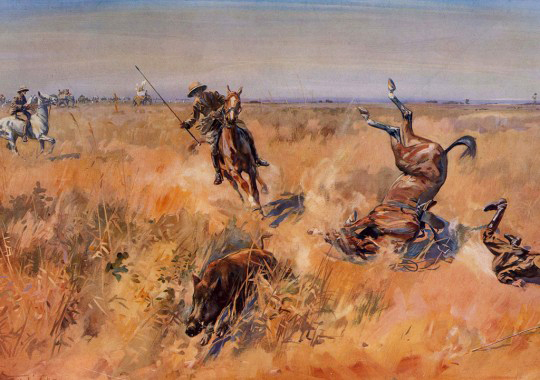
I was reading about polo in India and the role played by the British military in bringing polo from India to England, and thence to the United States, when I came across another British sport in India that involved a spear rather than a mallet, and an enraged boar rather than a ball.
Pig sticking certainly doesn’t have polo’s cachet, but for a time it had its own journal, Hog Hunters’ Annual, and books devoted to the subject, including Sir Robert Baden-Powell’s Pig-Sticking or Hog-Hunting: A Complete Account for Sportsmen and Others (1889), Reminiscences of Twenty Years’ Pigsticking in Bengal (1893) by “Raoul” and Modern Pig Sticking (1914) by Major A.E. Wardrop.

A watercolor by Snaffles
Pig sticking even had its own Super Bowl – the Kadir Cup – its own
toast – “To the Boar!” – and its own songs, most probably sung after
several toasts. A number of artists illustrated the sport for magazines
and prints, most notably Charles Johnson Payne (1884-1967), who signed
his sketches “Snaffles.” The sport thrived in India from the early 1800s
until just after World War II. Its essence was described by Major
General J.G. Elliott in his Field Sports in India 1800-1947:
“Armed with a nine-foot lance, the
pig-sticker rode a galloping horse in pursuit of wild boar which had
been flushed out of the bush by beaters. The aim was to stick the boar
immediately behind the shoulder, so that the spear would pass through
the lungs and out at the breast.”
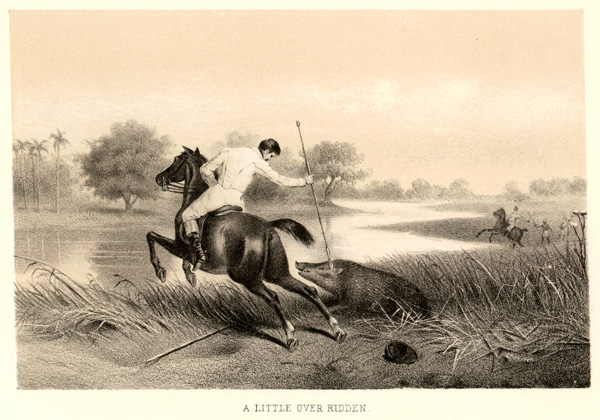
The sporting aspect came from the marked reluctance of the boar to cooperate. The boars of India grew up to five feet in length and three feet at the shoulder; Elliott wrote of one bad boy who measured 44 inches at the shoulder and weighed more than 400 pounds. Such boars ran as fast as a horse, could make a 90-degree turn at a full gallop (a practice known as “jinking”), and came armed with curved tusks up to 9 inches long, sharp teeth and a profoundly irritable disposition. When unable to outrun its pursuer, the boar turned and charged.
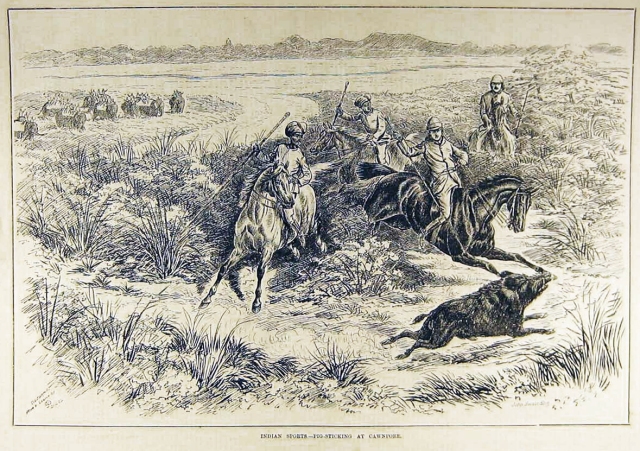
In the middle was the horse, who could be cut, even killed, by the boar’s tusks. And once speared, boars were known to struggle upwards on the lance to get to the wide-eyed man at the end.
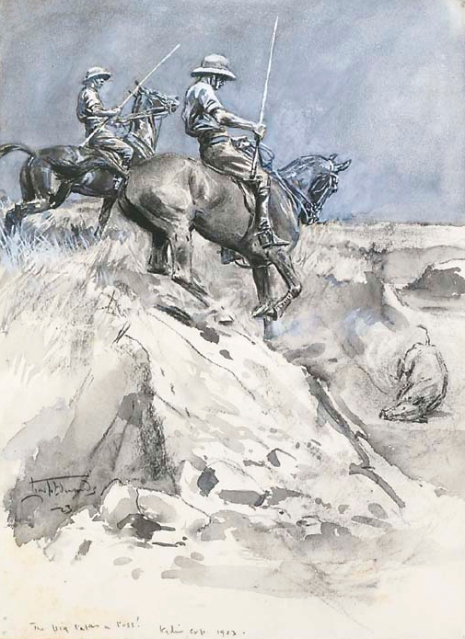
“The Pig Takes a Toss,” a sketch from the Kadir Cup of 1923 by Lionel Edwards (1878-1966)
The boar aside, the pursuit itself was dangerous. Elliott notes, “The
horse had to be able to remain upright when galloping full tilt through
thick grass six to nine feet high, over ground as hard as rock, seamed
with large and small nullahs [steep, narrow watercourses,
usually dry] and the occasional sunken buffalo wallow… Old, disused
wells, completely overgrown by long grass, were a constant hazard… in
1890, a Colonel Napier fell into one and broke his neck.”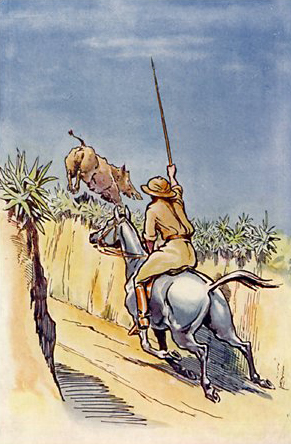
Watercolor by Sir Robert Baden-Powell
Baden-Powell offered this advice to riders:
“So, considering the extra dangers
inherent in pig-sticking it would be well for the beginner to cultivate
what art there is in falling, for all things are possible to the
hog-hunter who knows how to fall. The main thing is under all
circumstances to keep hold of your reins, for three reasons : first,
because it is at least a nuisance to be left horseless in the presence
of an angry boar ; secondly, because it may sometimes save you from
being dragged, if your foot catches in the stirrup; thirdly, because the
act of hanging on to the reins often gives the body a cant up at the
critical part of the pitch and so saves a broken collar bone.”
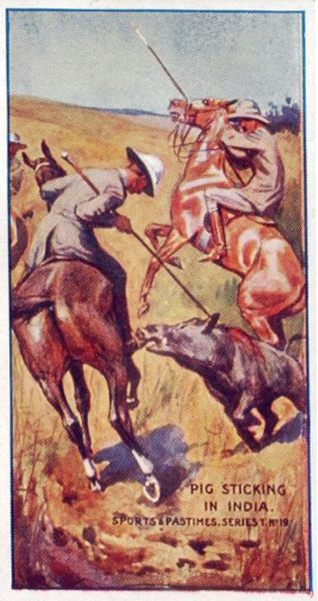
Cigarette trading cards
Pig stickers, much like polo players, sought horses suited to the task. Captain Scott-Cockburn wrote of his favorite mount:
“Carclew really loved a hunt. At the cry
‘woh jata’ (there he goes) I could feel his heart thumping between my
legs; once a boar had been singled out he would follow him as a
greyhound will a hare. In the open he would place me right to spear
within a minute. In thick tamarisk or grass it was no more necessary for
me to steer him than in the open. Whenever we lost a pig it was either
in impenetrable thorn, or when the cover was over my head. I think he
must have accounted for a good third of the 500-odd boar on which I got
‘first spear.’ In ten years’ hunting, he was never cut by a pig nor
missed his turn.”
“Tent clubs” served to organize the hunts, and their activities were reported in The Oriental Sporting Magazine.
The killing of female hogs was frowned upon, and pregnant sows always
received a pass. Any member of the Calcutta Tent Club who accidentally
killed a sow was fined 12 bottles of champagne.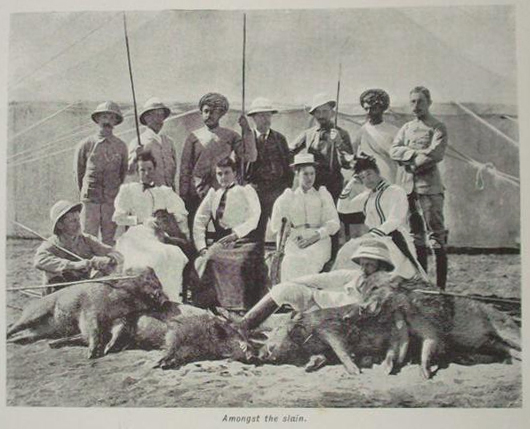
Photo from an 1895 magazine article;
the only image I’ve ever seen with women, and it could be me, but they
don’t appear to be too pleased. And below, a second image from the same
article.

The beaters were the final, and indispensable, members of the cast. Elliott wrote:
“Barefoot, clad only in a loincloth and pagri
[turban], and carrying a stout pole, a hundred of them in line would
beat through the high grass until a rideable boar emerged with a savage
‘woof-woof’ from a thicket. And all for a few annas a day.
There was, however, another attraction. Fox hunting has been described
as the ‘unspeakable in pursuit of the uneatable,’ but pig sticking has
the edge as pork was considered a great delicacy by the beaters.”
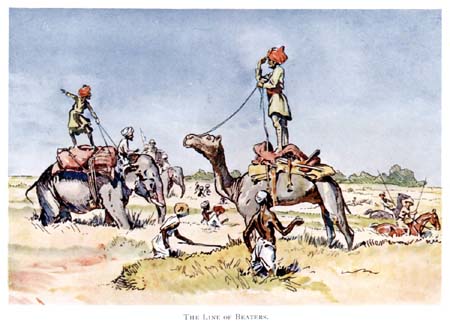
“The Line of Beaters” by Sir Robert Baden-Powell
The day’s hunt, in a field where temperatures might be over 100˚F in
the shade, would end at mid-day with a quick lunch, “plenty of cold
beer,” and a long nap before an evening visit to the horse lines and
then dinner in the mess tent where the men would talk about pig
sticking.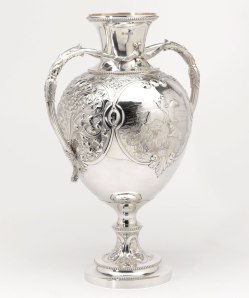
The Kadir Cup
The sport had its competitive side. First held in the 1870s, the
Kadir Cup was a competition for “first spear” and hosted more than 50
entrants annually. Groups of three were drawn and when a pig was flushed
the men galloped off, each trying to spear the pig and draw first
blood. The first to do so showed his spear to the umpire and went into
the next round. At day’s end, the winner received the entry fees and
with the money bought a replica of the trophy.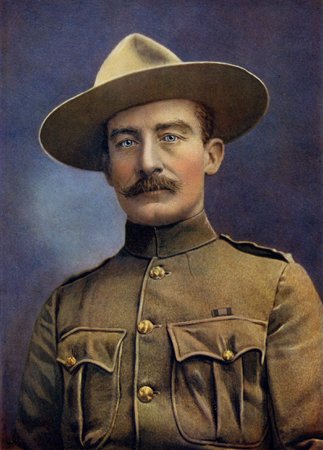
Lord Baden-Powell
The most famous winner of the Kadir Cup, in 1883, was Sir Robert
Baden-Powell, a Lieutenant-General in the British Army in India and
Africa, and the founder of the Boy Scout movement. In a chapter on pig
sticking in his autobiography, Lessons from the Varsity of Life (1933), he wrote:
“Yes, hog-hunting is a brutal sport – and
yet I loved it, as I loved also the fine old fellow I fought against. I
cannot pretend that I am not inconsistent. But are many of us entirely
consistent ? Do what we will and say what we like, although we have a
veneer of civilisation, the primitive man’s instincts are still not far
below the surface.”
Hog hunting in India came to an end after World War II, as cavalry
gave way to mechanized warfare and the British departed. The sport is
still pursued in other nations.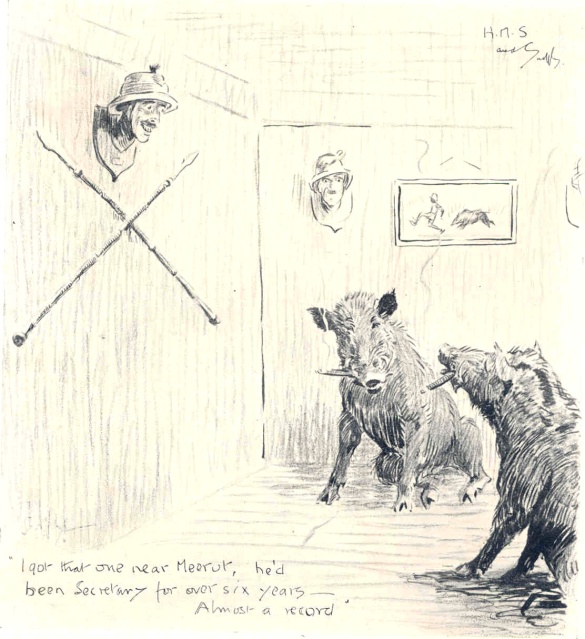
A particularly appropriate Snaffles sketch from Hog Hunters’ Annual



